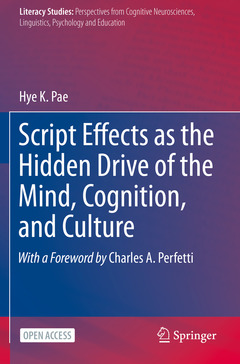Script Effects as the Hidden Drive of the Mind, Cognition, and Culture, 1st ed. 2020 Literacy Studies Series, Vol. 21
Auteur : Pae Hye K.
Préfacier : Perfetti Charles A.

This open access volume reveals the hidden power of the script we read in and how it shapes and drives our minds, ways of thinking, and cultures. Expanding on the Linguistic Relativity Hypothesis (i.e., the idea that language affects the way we think), this volume proposes the ?Script Relativity Hypothesis? (i.e., the idea that the script in which we read affects the way we think) by offering a unique perspective on the effect of script (alphabets, morphosyllabaries, or multi-scripts) on our attention, perception, and problem-solving. Once we become literate, fundamental changes occur in our brain circuitry to accommodate the new demand for resources. The powerful effects of literacy have been demonstrated by research on literate versus illiterate individuals, as well as cross-scriptal transfer, indicating that literate brain networks function differently, depending on the script being read. This book identifies the locus of differences between the Chinese, Japanese, and Koreans, and between the East and the West, as the neural underpinnings of literacy. To support the ?Script Relativity Hypothesis?, it reviews a vast corpus of empirical studies, including anthropological accounts of human civilization, social psychology, cognitive psychology, neuropsychology, applied linguistics, second language studies, and cross-cultural communication. It also discusses the impact of reading from screens in the digital age, as well as the impact of bi-script or multi-script use, which is a growing trend around the globe. As a result, our minds, ways of thinking, and cultures are now growing closer together, not farther apart.
Foreword by Charles A. Perfetti.- Prologue.- PART I. ORAL LANGUAGE, WRITTEN LANGUAGE, AND THEIR INFLUENCES.- Language, Cognition, and Script Effects.- The Emergence of Written Language: From Numeracy to Literacy.- From Linguistic Relativity to Script Relativity.- PART II. FROM THE SCRIPT TO THE MIND AND CULTURE.- The Alphabet.- Chinese, Japanese, and Korean Writing Systems: All East-Asian but Different Scripts.- The East and the West.- The Consequences of Reading: The Reading Brain.- Linguistic Evidence for Script Relativity.- Neurolinguistic Evidence for Script Relativity.- PART III. THE DIGITAL ERA AND READING.- The New Trend: The Word Plus the Image.- The Impact of Digital Text.- Conclusion: Convergence or Divergence between the East and the West?.- Epilogue.
Date de parution : 10-2021
Ouvrage de 251 p.
15.5x23.5 cm
Date de parution : 10-2020
Ouvrage de 251 p.
15.5x23.5 cm


